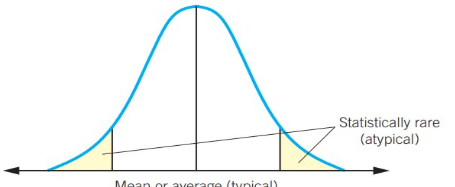1. Typical and atypical behaviour
Typical behaviour: Patterns of behaviour that are expected of an individual or that conform to standards of what is acceptable in a given situation
eg/When a child’s skills, abilities and behaviours fall within a expected range of development, or progress at a similar pace compared to peers of the same age.
General Level:
typical behaviour that most people would ordinarily do in a situation at that time
Individual Level:
at most times the person acts as they usually do in a given situation
Atypical behaviour: Patterns of behaviour that are not expected for an individual/ deviate from the norm and can be harmful or distressing for individual around them.
tend to violate what society feels is appropriate
eg/ Excessive violence, aggression, social withdrawal, self harm
General Level:
atypical behaviour that most people would not ordinarily do in a situation at that time
Individual Level:
at most times the person acts in ways that are unusual for them in a given situation
ie/ out of character
eg/ friendly person becomes withdrawn and does not interact with others for a period of time
Psychological criteria used to categorise typical and Atypical behaviour
Criteria’s can be used to determine if behaviour is typical or atypical, which can help identify if patient is in need of management & treatment
Cultural perspectives: involves using cultural norms/standards to determine whether behaviours are acceptable or typical for a certain culture (this may vary between cultures)
ie/ Eye contact in Hispanic, Asian, Middle eastern cultures is seen as rude but respectful in Western
limitations:
Typical and Atypical behaviour differs between countries, no universal standard
countries with higher cultural diversity make it difficult to assess Atypical & typical behaviours
values, beliefs, expectancies of cultures can change over time
Social norms
shared standards/ social beliefs on what is acceptable behaviour
govern what people should/shouldn’t do in different situations
aren’t written down/ explicitly stated
learned through socialisation in childhood
→ can be within different groups such as gender norms and age norms
eg/ throwing a tantrum as a baby is socially acceptable but not for adults
Limitations:
no universal agreement to social norms and may differ between individuals even within the same culture
can change over time with changes of society ie/online dating
may depend on situation or context
Statistic rarity
behaviours are considered abnormal if they deviate significantly from the mean
based on the normal distribution curve → normal behaviour falls in the middle area

Limitations:
the cut off area for typical or atypical behaviour is subjective
when viewing behaviour, both ends of curve is atypical
same behaviours may not be statistically rare but are atypical
e.g./ 1 in 7 aussies experience depression but it is atypical behaviour
Personal distress
usually involves unpleasant & upsetting emotions such as sadness, anxiety, overwhelmed as well as physiological pain and suffering, e.g./ loss of a loved one, life threatening disease, traumatic event, financial difficulty
considered atypical if distress is so intense, disruptive and persistent that it interferes with a person’s ability to function normally for a long period of time.
limitations:
experience of distress varies among individuals
personal distress may not occur even if behaviour is atypical
personal distress is not enough to describe behaviour as atypical but rather the severity of distress
Adaptive vs maladaptive behaviour
Adaptive behaviour
any behaviour that enables the individual to adjust to the environment appropriately and effectively → actions that someone carries out every day to need with their personal/social responsibilities
having a good nights sleep
dressing correctly for school
being productive at school
Maladaptive behaviour
behaviour that is unhelpful, dysfunctional and nonproductive that interferes with a persons ability to adjust to their environment appropriately & effectively
is effective for stress short term but tends to strengthen stress long-term as it does not address the root cause
interfere with ability to perform daily tasks
useful in assisting psychologists to identify individuals who are not functioning effectively.
e.g./ you have homework you are stressed about but instead you scroll on your phone to distract yourself
limitations:
how adaptive or maladaptive behaviour is hard to quantify
whether behaviour is maladaptive or not depends on situation (eg/ binge watching movies for fun or watching to distract yourself from work)
maladaptive behaviours can be categorised as typical when viewed from a statistical perspective

Explanation should demonstrate understanding that atypical development raises concerns when it is persistent, is evident across different situations in everyday life, and results in maladaptive behaviour i.e. interferes with the ability to successfully adjust to the environment.
S,S,C,M,P
"Soft music calms sleepy people."